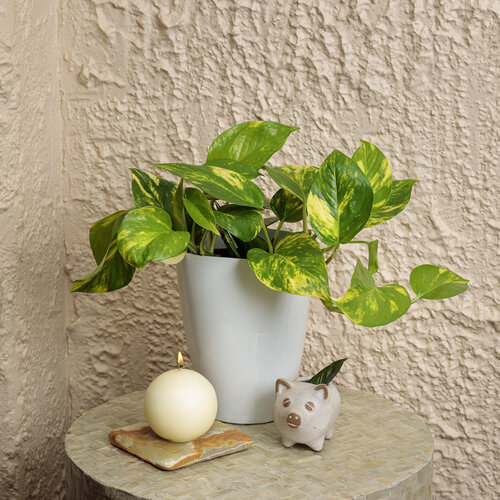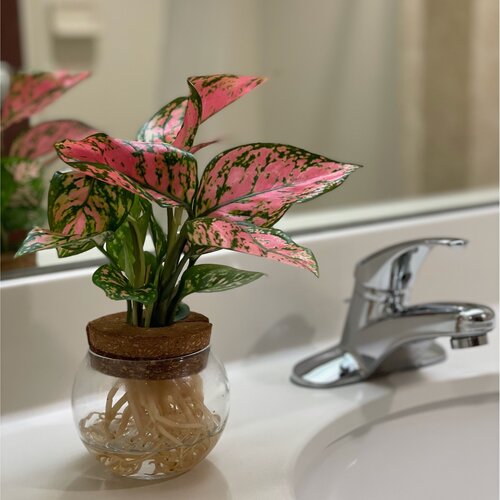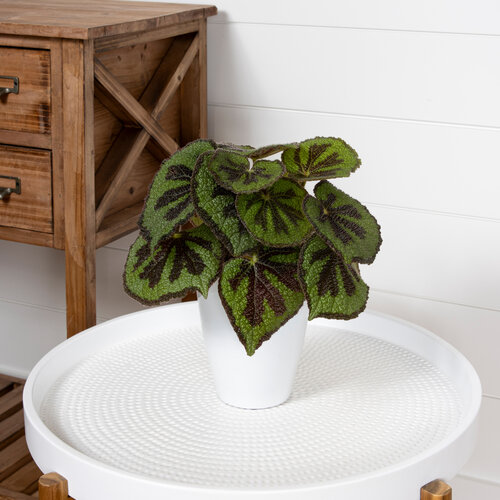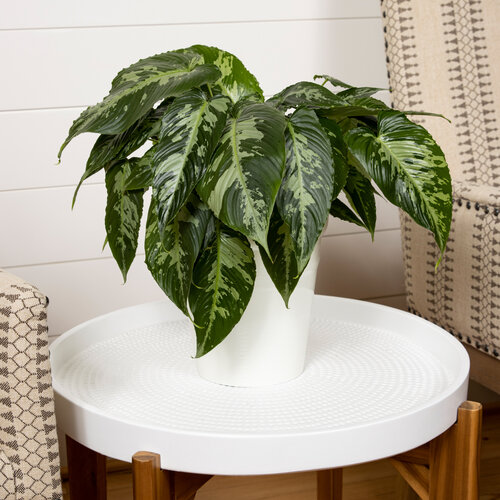14 Low-Light Houseplants That Thrive in Dim Spaces
These houseplant varieties will thrive even in dim indoor environments
Check here to see if The Home Depot® or your Local Garden Center is carrying leafjoy®.
All plants need at least some light in order to survive, with some plants needing more light than others. In recent years, more homeowners and apartment dwellers are growing indoor houseplants to add a living touch to home and office décor. Indoor environments have less light, presenting more challenges to keeping plants healthy.
The easiest solution is to grow low-light indoor plants that will thrive in darker environments. Many of these plants grow natively under the dense understory of tropical rainforests where little light penetrates the tree canopy. These tropical plants don’t need sunlight and will thrive in low-light conditions. Try these Proven Winners® leafjoy™ plant varieties in darker areas of your home or office.
 1. CORN PLANTDracaena spp. Corn plant, also known as dracaena, is characterized by an upright habit and strappy foliage in solid or variegated colors. These tropical houseplants can be grown as smaller specimens or large indoor trees that can reach 6 feet tall or more. Corn plant is easy to grow and tolerant of different light and other growing conditions. Bananacle™ has green foliage with wide yellow margins and leaves that curve around the central cane like bananas. Place in a spot with indirect light and moderate to high humidity. Display on a tabletop or office desk. Pictured: Submerged Relics™ Bananacle™ |
 2. POTHOSEpipremnum aureum Pothos is a tropical vining plant with heart-shaped leaves that looks nearly identical to philodendron. Plants are tolerant of a range of light and growing conditions. Beautifall® Summer Nights™ produces attractive foliage with irregular marbled patterns in green and gold. Provide bright indirect light from an eastern or western window, average moisture and good drainage. Display as hanging plants, or on a shelf or mantle where the vines can trail or sprawl. Pictured: Beautifall® Summer Nights™ |
 3. MOTHER FERNAsplenium difforme x dimorphum This Australian native fern produces lush dark-green foliage with a shiny sheen and thick waxy leaves that belie its delicate appearance. This versatile houseplant does best in medium indirect light but can tolerate low-light conditions. Place near a north-facing window, provide average moisture and rich, well-drained soil. The compact habit is suitable for display on a desktop or bathroom sink. Pictured: Living Lace® Parvati |
 4. NERVE PLANTFittonia albivenis Sometimes confused with polka dot plant, this tropical houseplant is differentiated by its low creeping habit and leaves with distinctive white, pink or red veining. This variety has emerald-green foliage with clean white veins, exuding understated elegance. Place near a north- or east-facing window, provide high humidity, moderate moisture and well-draining soil. Display in a tabletop terrarium, or use to brighten up a work space or sitting area. Pictured: Network News™ World Views™ |
 5. VELVET CALATHEACalathea rufibarba Calathea is a tropical plant grown for the decorative foliage that comes in an array of colors, patterns and shapes. When given the right indoor conditions, calathea is easy to grow. Plants do best in bright indirect window light and can tolerate low light, though their leaf markings may be less pronounced. This variety has furry stems and foliage with velvety undersides. Lance-shaped leaves are dark green with wavy edges. Display on a coffee table or bedroom nightstand. Pictured: Color Full® Lancelot™ |
 6. PRAYER PLANTCalathea louisae Prayer plant is named for the leaves that fold up at night, resembling praying hands. This vibrant tropical houseplant produces foliage in a range of colors, shapes and patterns. Plants prefer medium light, but can tolerate low-light conditions, though leaf color may fade somewhat. Color Full ® Thoreau™ produces oval foliage with wavy edges, with coloring that is dark green brushed with lighter green. Place in a room with high humidity such as a bathroom or kitchen and provide regular moisture. Pictured: Color Full® Freddie |
 7. CHINESE EVERGREENAglaonema x Chinese evergreen is an exotic-looking tropical with bold leaves in an array of bright colors and patterns. This variety produces glossy lance-shaped foliage with dark-green margins and veining, and irregular splashes of ruby pink and cream that resemble the blush of a crab. Plants do well even in rooms with only artificial lighting. Provide a humid environment, well-draining soil and moderate water. Display on an end table or bookcase. Pictured: Igneous™ Ruby Crab™ |
 8. SWISS CHEESE VINEMonstera adansonii Monstera is a vigorous vining plant with heart-shaped green leaves that develop slits and holes as they mature, resembling Swiss cheese. This tropical houseplant does best in bright indirect light and can tolerate low light, though growth will be slower. Plants can be kept trimmed back to retain a bushy habit, or allowed to climb or sprawl. Provide higher humidity, moderate moisture and extra drainage by adding orchid bark or perlite to the potting soil. Display on a tabletop or mantle, or provide a moss pole for plants to climb. Pictured: Mysteria® Adansonii™ |
 9. BIRD'S NEST FERNAsplenium antiquum This evergreen produces thick, shiny, wavy-edged leaves in a rosette form that resembles a bird's nest. Living Lace® Hurricane has deeply curved lance-shaped green leaves that swirl around its center axis like the eye of a hurricane. Bird’s nest fern thrives in bright indirect window light, but can also tolerate low-light conditions. Provide high humidity, moderate moisture and good soil drainage. Display this compact variety on a coffee table or book shelf. Pictured: Living Lace® Hurricane |
 10. IRON CROSS BEGONIABegonia masoniana Named for the deep burgundy leaf pattern that resembles an iron cross, the rounded bright-green leaves have a rough hairy texture and irregular edges. Plants can be grown in shady locations outdoors during warmer months or as an indoor houseplant. The compact habit is suitable for display on an end table or bathroom countertop. Provide moderate humidity, regular moisture and well-drained soil. Plants are tolerant of low light, though they may become leggy and coloring will be less pronounced. Pictured: Bold Belles™ Criss Cross™ |
 11. ROCK BEGONIABegonia masoniana This variety of rock begonia has heart-shaped olive-green leaves with a velvety texture. The leaves and stems produce fine fuzzy hairs with undertones of deep maroon for a sophisticated two-toned effect. Begonias thrive in a spot with medium indirect light, but can tolerate low-light conditions. Provide moderate humidity and moisture and well-drained soil. Display on an office desk or bathroom countertop. Pictured: Bold Belles™ Crystalline Sparkle™ |
 12. DROP TONGUE PLANTSchismatoglottis wallichii This exotic rainforest native is an unusual species with large heart-shaped leaves that drape downward elegantly like a dropped tongue. Dark-green foliage is irregularly splashed with ice-green markings, with a rippled texture that adds depth and dimension to indoor decor. Plants prefer bright indirect light but can tolerate low light, though coloring will be less pronounced. Provide moderate humidity, regular moisture and well-drained soil. Display on a coffee table or dining room table as a conversational focal point. Pictured: Art Deco™ Rivera |
 13. STROMANTHEStromanthe sanguinea Native to Amazonian jungles, this exotic plant produces shiny lance-shaped leaves with veined patterns or irregular splotches of pink, red or creamy white. Socialite™ Stripestar has dark-green veined leaves with reddish-purple undersides. This houseplant is somewhat more finicky than other types, preferring moderate to high humidity, good drainage and regular moisture. Plants may be sensitive to tap water, with distilled water a better option. Display this upright plant on a dining room table or desktop. Pictured: Socialite™ Triostar |
 14. ARROWHEAD VINESyngonium podophyllum Named for the distinct arrow-shaped leave, this houseplant has foliage in a range of colors and variegated patterns, developing a trailing habit as plants mature. Falling Arrows® Ruby Reign™ produces small heart-shaped leaves with mottled cream and green variegation and striking ruby-red veining. Plants prefer bright indirect light and are tolerant of low light, though coloring will be less pronounced. Provide moderate humidity, consistent moisture and rich soil with good drainage. Place on a desktop or bookshelf. Pictured: Falling Arrows® Ruby Reign™ |
Frequently Asked Questions
What plants thrive in low light?
Many houseplants don’t need a lot of light, with some thriving in low light. Some of the best low-light indoor plants include calathea, cast iron plant, monstera, philodendron, pothos, prayer plant, snake plant, spider plant and zz plant.
See more low-light plants: Proven Winners® leafjoy® Cocoon® Collection
Where do you put low-light plants?
Place near a window that receives indirect light. Plants that are displayed further away from windows can be rotated between brighter and darker spots in a room to give them a boost of natural light.
How do you keep plants alive in a low-light apartment?
Some plants are more resilient to low-light conditions than others. If plants display symptoms of too little light such as leggy growth or faded coloring, move to a brighter spot near a window.
Can low-light indoor plants survive in windowless rooms?
Plants may survive with no light from windows or other sources, but may fail to thrive. In rooms with no windows, light levels for plants can be boosted with an artificial grow light.
How often should I water low-light indoor plants?
Watering needs depend on the individual plant. Most low-light plants originate in tropical rainforests, preferring consistent moisture. Water when the top 1 to 2 inches of soil is dry. Don’t allow soil to dry out completely, and avoid overwatering to prevent root rot and other fungal diseases. Follow instructions for each type of plant, and group plants together with similar watering needs. Reduce watering during winter months when plant growth slows down.
Do low-light indoor plants need fertilizer?
Most low-light tropical houseplants perform best with regular fertilizing during warmer months when they are actively growing. Research each plant and fertilize according to instructions. Cease fertilizing during winter months when plant growth slows down.
How do I prevent low-light indoor plants from getting leggy?
Provide the minimum amount of light for plants to thrive. If growth becomes tall and leggy, move plants to a spot with more light. Cut back leggy growth to encourage new growth and a bushier habit.
What are some pet-friendly low-light indoor plants?
Many houseplants can be toxic to curious pets, which may chew on or ingest the foliage. Place toxic plants out of reach or only grow houseplants that are non-toxic. Low-light houseplants that are non-toxic to pets include bird’s nest fern, calathea, cast iron plant, Chinese money plant, nerve plant, parlor palm, peperomia, polka dot plant, prayer plant, rubber plant, spider plant and wax plant.
Are there flowering low-light indoor plants?
Though most plants don’t bloom indoors, there are a few houseplant varieties that will flower in low light when given the right growing conditions. These include African violet, anthurium, bromeliad, kalanchoe, peace lily, pothos and spider plant.
Do low-light indoor plants need humidity?
Many low-light indoor plants are native to humid tropical regions and benefit from additional room humidity, particularly in winter when home and office environments are dry from supplemental heating. To boost room humidity, use a humidifier, mist plant foliage, or place pots on a tray filled with pebbles and water. Don’t allow the bottom of the pot to stand in water to prevent root rot.
How do I identify if my plant is getting too little light?
There are a number of symptoms that plants are receiving too little light. These may include weak, leggy or stunted growth; faded foliage color; yellow or brown leaves, especially at the bottom of the plant; and general failure to thrive.




